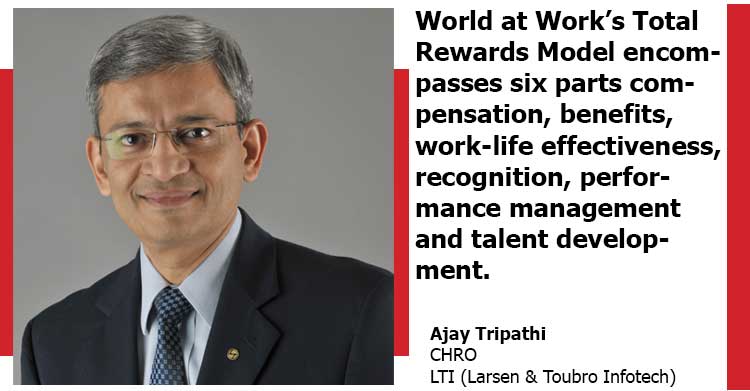Demystifying Rewards | Ajay Tripathi | CHRO | LTI (Larsen & Toubro Infotech)

World at Work’s Total Rewards Model encompasses six parts compensation, benefits, work-life effectiveness, recognition, performance management and talent development. Rewards can be simply defined as the receivables on account of a person being in association with a company. Rewards are not entitlements barring a part of compensation and statutory benefits and it should not be seen as such.
Rewards forms the core of employee value proposition, thus a differentiated total reward practice become a question of strategy with implication on areas such as employer branding, mergers and acquisition. Let us decode the concept of ‘Total rewards’ barring the necessities of base compensation, statutory benefits and cost of living adjustments.
Incentives and Bonus
Incentives and Bonus have a specific purpose of achieving tangible outcomes. It sits well with the symbiotic relationship between employee and employer. Organization cascading its goal to individual levels as milestones or goals and sharing monetary dividends. But, in order for this to work the goals need to follow the SMART criteria, else the benefits of Bonus and Incentives are seldom realized.
The key difference between Incentive and Bonus is while bonus rewards past performance, incentives explicitly try to influence future behavior. The difference is subtle but important, like for example a business head should receive a quarterly bonus if he increases revenue higher than the industry average, but he should receive an incentive if a part of that revenue increase is in say digital technology. This will signal to the person that increasing the digital revenue is companies strategic focus and he should align in that direction.
Recognition as a Nudge
Recognition unlike compensation, which is laden in secrecy, thrives on promotion. The higher the visibility of the award, greater is its worth to the receiver. Recognitions connects deeply with relational return of work. In most companies it currently exists in both monetary and non-monetary forms. Designing a recognition model for any organization is a creative process, since it is neither regulatory requirement nor an expressed need of employees.
Recognition should be given to appreciate specific traits like attention to details or timeliness. The latent power of recognition is its sociability; thus, it not only emboldens the receiver to strive for more but inspires the visible social circle to get recognized themselves. It should trigger a positive competition among the target set. One fatal error that most recognition programs suffer is not managing the frequency-audience ratio. For Example, instituting an Employee of the Month award among a twelve-member project team leads to a round-robin approach taking away the exclusivity which embellishes its desirability.
Recognition can also be focused such as identifying next-gen leaders or celebrating women leadership while other rewards methods are mostly blind. Organizations lately have also busted the myth that recognition has to flow from the top, now peer to peer awards and mentor awards are in vogue. One key challenge with recognition scheme is under-utilization, thus it becomes imperative to include it in manager dashboards or promote it regularly.
Work-Life Effectiveness
‘A happy and healthy employee is a productive employee’, this can be considered a philosophy carved in stone for effective HR management. A look at the modern workplace is an embodiment of this believe: Open workspaces, paid vacation, Gymnasium, paternity/maternity leave, work from home, recreational centers etc. the list is non-exhaustive and ever increasing.
Organization are beginning to understand and recognize the need of employees and benefits it can reap by establishing a family like culture increasing belongingness of employees.
Wellness program are being increasing promoted among organizations like rewarding for logging hours run. The “WeWork phenomena” is redefining how our workspace needs to change to increase collaboration and get rid of the cubicle mindset. We would see more ingenious steps for better work-life in the years to come.
Talent Development
The changing landscape has necessitated organization and individual to focus on talent development. The beginners joining the industry are increasing finding the knowledge imparted in degree courses wane in a couple of years. Each profession is going through a tectonic shift with the advent of artificial intelligence and machine learning. The jobs that are repetitive and mundane are increasingly being automated, thus the workforce has to re-skill themselves in a continuous manner to be relevant.
The millennial workforce is slowly but surely gravitating towards freelance work because it allows them the option to choose their work. They are increasingly looking for change in the nature of work. To augment this need there are a plethora of online based learning platform, both open source and paid. Information is available for everyone but carving a career path still remains less understood. There is a disjoint between the individual’s area of study and work available. Organizations are becoming cognizant of this and allowing cross-functional roles through internal job posting, Re-imbursement of courses, supporting higher education and designing interviews to access where the candidates interest lie rather than just evaluating his suitability in the current role.
Rewards offer a unique opportunity for employer to place their brands in the minds of their future employees. A mere imitation of market leaders will not go far in realizing the potential that rewards has to offer. The investment incurred has to be meticulously planned to optimize returns and those returns will act as a reward for the organization as a whole.


